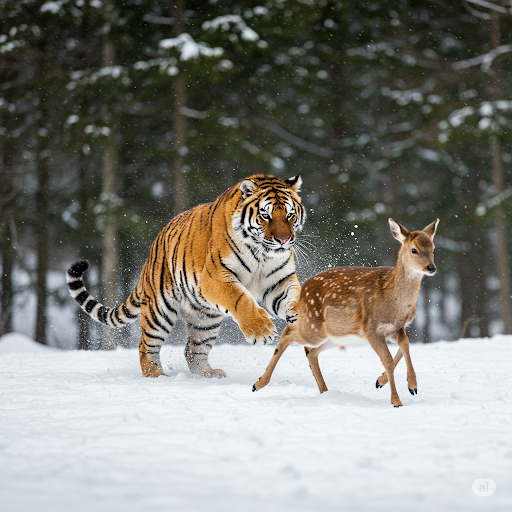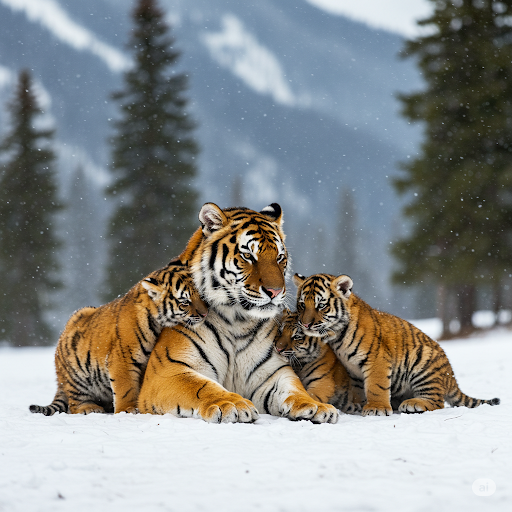Siberian Tiger (Panthera tigris altaica) is a large predatory cat species native to the eastern part of the Asian continent and is currently classified as endangered. This subspecies is considered the largest wild cat in existence and is notable for its powerful physical structure. Adapted to cold climates, the Siberian tiger survives in snow-covered forests thanks to its thick, dense fur. This tiger species is found exclusively in the Russian Far East, particularly in the Sikhote-Alin Mountains. Despite having a wide natural habitat, its population is rapidly declining due to habitat loss, hunting, and illegal trade.
Morphological Characteristics
The Siberian tiger is larger and heavier compared to other tiger subspecies. Male individuals can weigh between 180 and 306 kilograms, while females are generally lighter, weighing between 100 and 167 kilograms. Adult tigers can reach a body length of 2.7 to 3.3 meters. Their fur is thick and dense, providing protection against cold climates. The coat color is typically orange with distinct black stripes on the body. During winter months, their fur becomes paler and thicker. Their eyes possess features that help them navigate and hunt in harsh natural conditions.

A Sleeping Siberian Tiger (Generated by Artificial Intelligence)
Ecology and Habitat
The Siberian tiger inhabits forested areas in the Russian Far East. Its natural habitat consists of dense pine forests and vast, undisturbed mountainous regions. These tigers utilize large territories for hunting and marking their living areas. The natural prey of the Siberian tiger includes deer, wild boar, and various other medium-sized mammals. Tigers approach their prey quietly and execute sudden attacks. This strategy demonstrates their excellent adaptation both to environmental conditions and to the behavior of their prey. This subspecies leads a solitary life and roams over extensive areas to establish its own territory. Each individual attempts to avoid interaction with other tigers and generally moves alone.

A Hunting Siberian Tiger (Generated by Artificial Intelligence)
Behavior and Reproduction
The Siberian tiger leads a solitary lifestyle, with each individual marking its own extensive territory. Tigers may roar loudly in moments of danger, but they are generally quiet in their daily activities. The breeding season primarily occurs during the winter months. Female tigers give birth to 2–4 cubs after a gestation period of approximately 3 to 3.5 months. Newborn cubs are born completely blind and are nurtured by their mother. The cubs remain with their mother until about two years of age, during which time they learn essential hunting skills. Male cubs typically leave their mother’s territory upon reaching adolescence, while female cubs usually stay within their mother’s range. The reproductive cycle depends not only on natural living conditions but also on the availability of prey.

Siberian Tiger Family (Generated by Artificial Intelligence)
Conservation Status and Threats
The Siberian tiger is classified as "Endangered" by the International Union for Conservation of Nature (IUCN). The species faces the risk of extinction mainly due to habitat loss, illegal hunting, and a decline in prey availability. In the early 20th century, the population of the Siberian tiger drastically decreased, and during the final years of the Soviet Union, poaching intensified, pushing their numbers to critically low levels. At that time, the population was reduced to only a few hundred individuals. However, in recent years, national and international conservation efforts have led to a population recovery. Projects like the Siberian Tiger Project focus on monitoring the species, restoring habitats, and combating illegal hunting.
Human Interaction and Cultural Significance
The Siberian tiger holds great symbolic value in Russian culture. Protecting its natural habitat is essential for maintaining biodiversity and ecosystem balance. However, human activities such as expansion of settlements, deforestation, and illegal hunting have reduced the tiger’s living spaces and caused conflicts between tigers and humans. Occasionally, tigers attack domestic animals, which generates fear and concern among local communities. To mitigate these issues, education and awareness programs are implemented. Government policies and civil society initiatives aim to promote coexistence between the species and human populations.


